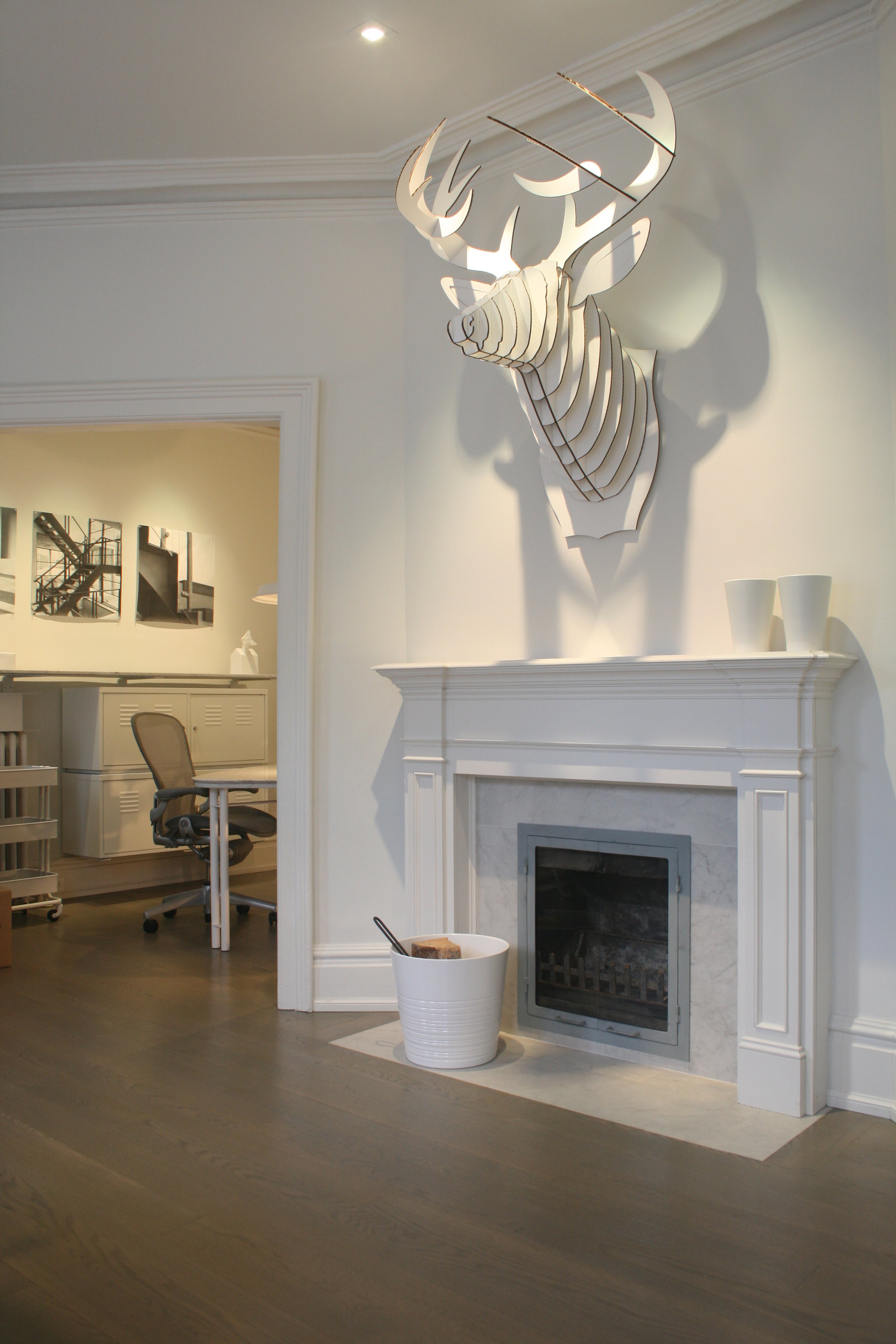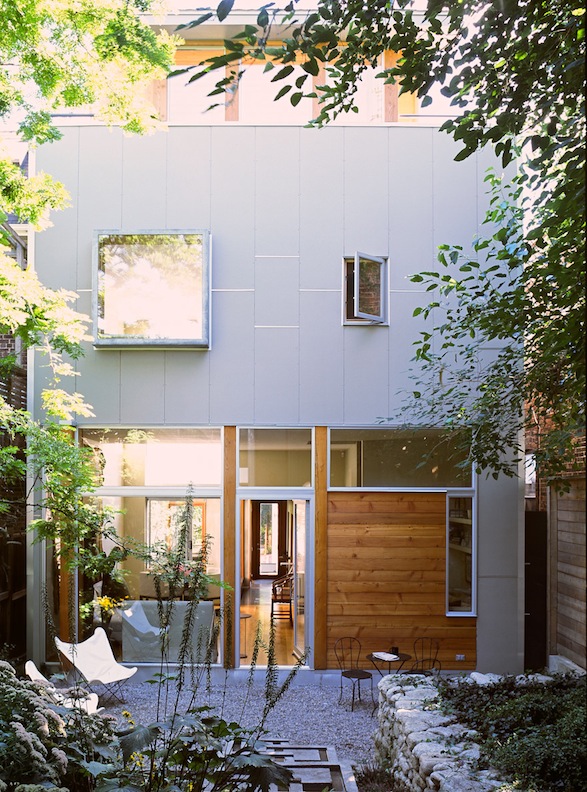Moving from a three-storey house to a one bedroom flat allowed Helen Rayne and Jane O’Hara to adopt a cool, modern aesthetic. Their rallying cry “Death to tchotchkes”
A warren of low-ceilinged, gumwood trimmed rooms, the apartment had spelled domesticity in 1920s Toronto. But in 2001, it simply looked dark and congested and had what the owner’s called “an old lady feel.” The two top floors of a standard-issue three storey brick box, it had a living room that overlooked traffic-ridden St. Clair East. Across the mangy hall, a trio of dismal little rooms lined up. The kitchen, a dispirited cavern, faced the garage, and a short staircase led from there to an attic bedroom.
Jane O’Hara and Helen Rayne bought the apartment, along with the rest of the building, five years ago as a rental property. At the time, they lived with their Wheaton terrier in a tall, vaguely Georgian house on Summerhill Avenue. In addition to the usual spaces, its three storeys accommodated two guest rooms, separate offices and a spacious music room. O’Hara spent hundreds of hours coaxing the shady-65-foot long garden into bloom, While Riley, The Wheaten, tore up and down in an unflagging search for smaller forms of life.
Although they loved the Summerhill house, both women were finding it increasingly burdensome. Rayne fancied more of a pied-a-terre, a place she could forget while she traveled or spent time in Vancouver, where she has a house. O’Hara chafed at the taxes and the cost of upkeep. A prize-winning journalist and staff writer at Maclean’s, she wanted to work less, on a freelance basis, and she started to see the house as “all that money sitting there.” Rayne, who founded a consulting company in Vancouver in the 1980’s and now specializes in executive coaching, had an immediate response to O’Hara’s suggestion that they shift to the apartment: “I will never live on St. Clair. I didn’t work this hard to live on a busy street.” That kind of amiable dissent marks their relationship. So does an equitable division of emotional labour, where O’Hara frets about financial security but is otherwise sanguine, while Rayne combines a sharp head for business with a free spirit.
Still debating about where to live (Rayne liked the idea of a small townhouse in Yorkville), they rather suddenly sold the Summerhill house in the fall of 2001. In O’Hara’s case the “apocalyptic mood” create by 9/11 may have contributed, but both women, in their 50’s were ready to pare down and rethink their priorities. Rayne still wasn’t keen on the St. Clair apartment, but O’Hara persuaded her that if they didn’t like the renovation they would rent I out and but something else. As befits and investigative reporter, O’Hara is a straight shooter; Rayne likes to tease. It makes for a couple who do the unexpected, even without complete unanimity. Trading their 3,500-square-foot house on a quiet street for half as much space on a noisy one is a case in point.
What they wanted was loosely defined: “light, informal, open, a beautiful space where we can entertain with closets and separate offices,” in Rayne’s words. Neither had much in the way of concrete ideas about how to morph the fussy “old lady” in to the breezy contemporary flat they imagined.
Cue John O’Connor, an architect and acquaintance. One night, while still undecided, they took him over to the St. Clair apartment. “Tell us the truth,” they said. “Can you do anything with this?” The architect responded, “It has to be something radical.”
O’Hara and Rayne hired O’Connor not because they ever completely visualized his design, but because they more or less trusted (O’Hara more, Rayne less) that he could translate their nebulous wishes into reality. A hands-on direct personality who knew as a toddler that he wanted to build things (his first drawing was of a construction site), O’Connor runs a design-build company-meaning he came with an experienced crew of stoneworkers, tile setters, carpenters and electricians. When it came to the “old lady”, his main idea was to orient the living room, dining room and kitchen to the north, away from St. Clair. He toyed with four or five plans, all reversing the original layout and turning their back to the street. A wide hall would house O’Hara’s baby grand piano and the dining table. A back porch and sunroom would be enlarged and transformed into a glassy cube of a living room, warmed by ribs of reclaimed Douglas fir. (An advocate of salvaged wood, for its texture and history, O’Connor chose Douglas fir for the structural beams as a nod to Rayne’s West Coast affiliation.)
Accommodating his client’s need for a live work space, O’Connor turned the old living and dining rooms to the right of the entrance door into an office suite. For O’Hara (who craved light more than space), there would be a small office overlooking the street. Rayne (the untidy one, she wanted more space than O’Hara, to hide her surfeit of papers) would get the old dining room, and the two would share and in formal sitting room.
Unlike in the modernized living-dining area, O’Connor set out to “respect the integrity” of the 1923 house in the office suite. Seeing beyond the indigenous frumpiness of the Arts and Crafts style to its sheltering intimacy, he fiddled with the details but kept the envelope. “It’s a house of a certain age in a certain neighbourhood,” he says. “That’s part of the story.” Preserving the dark green-tiled fireplace with its distressed brass outline, he installed another big piece of reclaimed Douglas fir for the mantel and replaced the grandmotherly side cabinets with his own open shelves. The vintage knobs stayed, as did the rounded arch between the sitting room and O’Hara’s office. The windows kept their original shape but were triple-glazed to minimize street noise. Other period details got painted out or simplified, and O’Connor designed a shelf that runs around the suite, unifying it, upgrading the IKEA storage underneath it and making space for family pictures and other mementoes (among them O’Hara’s four Wimbledon competitor’s tags from 1969 to 1972, a souvenir of her youthful tennis career).
For the attic bedroom, O’Connor wasn’t about to reinvent the wheel. The main floor was more important to his clients, so he contented himself with a few frugal interventions. The result, with its peaked roof and unpainted plywood-panelled walls, is a surpassingly cozy ark for sleeping and watching television. In addition to installing triple-glazed panes up here as well, between the front window and the bed he added further insulation with a novel material: clothing. Camouflaged by a partial wall behind the bed, a casual closet-dressing room, its contents simply hidden by linen curtains, muffles noise and conserves heat.
Remarkable, for two take-charge characters, the women mostly let O’Connor run with his vision. O’Hara says she always knew when the architect didn’t like one of their ideas: “He would take a few steps back while listening respectfully. These steps back invariably meant that it was a no go.” But she demurs when it’s suggested that they were an architect’s dream. “Helen was not the perfect client,” she says, not because she is a goody two-shoes, but because she has to set the record straight. Rayne would wring her hands over the living room’s low ceilings, and O’Hara would urge, “Let’s just give John a chance to finish before you throw in the towel.” Meanwhile both found unexpected therapy in clearing out their basement at Summerhill-“like cleaning your id,” O’Hara reports. The rallying cry for moving house and home was “lighter” -less responsibility, fewer burdens, and death to tchotchkes.
Last April 23, they moved into something that was part home, part construction site and entirely according to John O’Connor’s meticulous master plan. Their bedroom, with its luxurious ensuite bath, was ready, as were the offices and sitting room at the front of the house. But the rest was chaos, hidden behind plastic sheets, a blue tarpaulin and a temporary plywood wall.
The finished areas said good things about O’Connor-his frugality, for one thing, as evidenced in his sagacious ways with the storage cabinets, and Beryll, a $60 IKEA light fixture used in the bedroom and sitting room. (Occasionally bemused by clients in the grip of “pedigree fixation,” he marvels, “Five hundred dollars for the world’s best toilet, yet they’re eager to spend $1,800 for a brand.”)
It was a promising start, but Rayne and O’Hara still didn’t have much sense of what was going on behind the tarp. They feared the hall-dining room was going to look like a large tunnel. “Riley and I were very depressed,” Rayne remembers. The dog wouldn’t eat and wouldn’t go out, moped around her new quarters. Rayne dates her own nadir to a blustery April day when here office was in a shambles and the apartment was as dark as her mood. As she tried to back her car out onto St. Clair, “where I never wanted to live,” she was convinced the move had been a terrible mistake.
The turning point came two months later, when O’Hara and Rayne returned from a week in Vancouver to see the wide-planked reclaimed black ash floors laid in the hall and living room. Even more dramatic, with the tarp finally removed, was the living room. Rayne thought, “A tree house!” Dominated by windows, it seems to float in space, engulfed by the fingerlike tress of their neighbours’ tree. The room, both arresting and soothing, inspires metaphors. O’Connor thinks of it as a pavilion. Anchoring it is a gleaming white limestone box of a fireplace, which in the early evening, illuminated by two pot lights, strikes O’Hara as a domestic altar. Far from the gloomy tunnel that they feared, the hall-dining room is spacious. The living-room ceiling is distinctly lower than the dining room’s-but that’s only discernible once it’s pointed out. From O’Connor’s bag of tromp l’oeil tricks came a simple, modern archway that separates the two rooms and seemingly raises the lower ceiling.
Rayne and O’Hara’s downsizing had effectively eliminated guest rooms, but they still wanted a shower in the main floor washroom, just in case. O’Connor shoehorned it in by rounding the hall wall, which softens the long rectangle and screens the kitchen with its gentle curve. European style, the egg shaped washroom, entirely lined in apple green tiles and outfitted with a drain, conveniently doubles as the shower when the need arises. The kitchen-a calm meeting of limestone the colour of face powder, stainless steel appliances and a painstakingly trowelled concrete counter- affords its own verdant view of mature gardens and trees, spiked by the occasional blue spruce
Once the wraps were off the north end, everything seemed to fall into place. A born-again devotee of second-floor living O’Hara claims, “Once you think about it, down at ground level is not usually a nice place to be.”
A tour through their aerie demonstrates the benefits of simplification – more like distillation in their case. The extraneous is gone, leaving the things that matter, like the selection of family pictures; flower-choked canvas by the Vancouver painter Jamie Everard in Rayne’s office; and a memento of O’Hara’s Ottawa years, the satirical paintings chez Mulroney by the former prime minister’s embittered chef and household coordinator, Francois Martin, in the sitting room. Other than two midnight brown leather club chairs from Roots that face the living-room fireplace and a long, chunky dining table designed by O’Connor, there are relatively few new possessions. And each one is warmly debated by the potential owners, as are a few unresolved issues. Rayne for example wants to put a whitewash on the plywood walls in their bedroom; O’Connor and O’Hara don’t. Every time Rayne gets a visitor to agree with her, there’s a loud crow from the bedroom.
The work came in on time and within the $200,000 budget. The unexpected expenses were almost always the clients’ doing, as on the famous day when Rayne insisted on a brushed stainless steel faucet, at $300 more that the shiny one that O’Connor had installed. The “skinflint” architect jumped in the truck and tore off to procure the new hardware. “Clients focus on the details,” he says indulgently.
O’Hara, a freelance writer wishes that her office were a tad bigger. And her chic concrete counter (she is the family cook) is turning out to be more maintenance that she bargained for. “Just use it and call the stains patina,” O’Connor tells her, but she points out a dingy sidewalk and says, “See that? That’s the future of my concrete counter.”
Rayne admits to a certain nostalgia for the Summerhill garden: “I miss Jane and Riley sitting out on the back stoop in the evening, looking at the garden together.” But O’Hara, who tends the handkerchief-sized plot on St. Clair, says she loves the attention she gets from passers-by.
Beyond those details, the two women are superbly content. Not only happy, they seem genuinely surprised that an impulse move verging at times on the tentative has resulted in quarters both stylish and unconventionally tailored to their wants. Rayne, the doubting Thomas, feels she’s the daily beneficiary of John O’Connor’s passion for materials and attention to detail. O’Hara, the St. Clair booster from the start, adds: “No way I ever dreamed it would be this nice.”
















